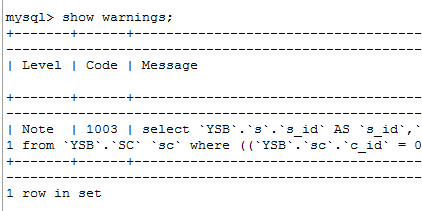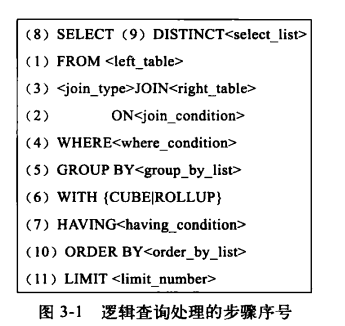SQL优化的魅力!从 30248s 到 0.001s
阅读本文大概需要 7.5 分钟。
来自:cnblogs.com/tangyanbo/p/4462734.html
场景
create table Course(
c_id int PRIMARY KEY,
name varchar(10)
)
create table Student(
id int PRIMARY KEY,
name varchar(10)
)
CREATE table SC(
sc_id int PRIMARY KEY,
s_id int,
c_id int,
score int
)
select s.* from Student s
where s.s_id in (
select s_id
from SC sc
where sc.c_id = 0 and sc.score = 100 )
EXPLAIN
select s.* from Student s
where s.s_id in (
select s_id
from SC sc
where sc.c_id = 0 and sc.score = 100 )

CREATE index sc_c_id_index on SC(c_id);
CREATE index sc_score_index on SC(score);

SELECT
`YSB`.`s`.`s_id` AS `s_id`,
`YSB`.`s`.`name` AS `name`
FROM
`YSB`.`Student` `s`
WHERE
< in_optimizer > (
`YSB`.`s`.`s_id` ,< EXISTS > (
SELECT
1
FROM
`YSB`.`SC` `sc`
WHERE
(
(`YSB`.`sc`.`c_id` = 0)
AND (`YSB`.`sc`.`score` = 100)
AND (
< CACHE > (`YSB`.`s`.`s_id`) = `YSB`.`sc`.`s_id`
)
)
)
)

select s_id
from SC sc
where sc.c_id = 0 and sc.score = 100

select s.*
from Student s
where s.s_id in(7,29,5000)
SELECT s.* from
Student s
INNER JOIN SC sc
on sc.s_id = s.s_id
where sc.c_id=0 and sc.score=100
sc_c_id_index,sc_score_index 。
CREATE index sc_s_id_index on SC(s_id);
show index from SC


SELECT
`YSB`.`s`.`s_id` AS `s_id`,
`YSB`.`s`.`name` AS `name`
FROM
`YSB`.`Student` `s`
JOIN `YSB`.`SC` `sc`
WHERE
(
(
`YSB`.`sc`.`s_id` = `YSB`.`s`.`s_id`
)
AND (`YSB`.`sc`.`score` = 100)
AND (`YSB`.`sc`.`c_id` = 0)
)


SELECT
s.*
FROM
(
SELECT
*
FROM
SC sc
WHERE
sc.c_id = 0
AND sc.score = 100
) t
INNER JOIN Student s ON t.s_id = s.s_id

CREATE index sc_c_id_index on SC(c_id);
CREATE index sc_score_index on SC(score);
SELECT
s.*
FROM
(
SELECT
*
FROM
SC sc
WHERE
sc.c_id = 0
AND sc.score = 100
) t
INNER JOIN Student s ON t.s_id = s.s_id

SELECT s.* from
Student s
INNER JOIN SC sc
on sc.s_id = s.s_id
where sc.c_id=0 and sc.score=100

show index from SC
SELECT s.* from
Student s
INNER JOIN SC sc
on sc.s_id = s.s_id
where sc.c_id=81 and sc.score=84

c_id=81检索的结果是70001,score=84的结果是39425。c_id=81 and score=84 的结果是897,即这两个字段联合起来的区分度是比较高的,因此建立联合索引查询效率。alter table SC drop index sc_c_id_index;
alter table SC drop index sc_score_index;
create index sc_c_id_score_index on SC(c_id,score);

总结
mysql嵌套子查询效率确实比较低 可以将其优化成连接查询 连接表时,可以先用where条件对表进行过滤,然后做表连接
(虽然mysql会对连表语句做优化)建立合适的索引,必要时建立多列联合索引 学会分析sql执行计划,mysql会对sql进行优化,所以分析执行计划很重要
索引优化
单列索引
select * from user_test_copy where sex = 2 and type = 2 and age = 10
CREATE index user_test_index_sex on user_test_copy(sex);
CREATE index user_test_index_type on user_test_copy(type);
CREATE index user_test_index_age on user_test_copy(age);

type=index_merge多列索引
create index user_test_index_sex_type_age on user_test(sex,type,age);
select * from user_test where sex = 2 and type = 2 and age = 10

select * from user_test where sex = 2
select * from user_test where sex = 2 and type = 2
select * from user_test where sex = 2 and age = 10
索引覆盖
select sex,type,age from user_test where sex = 2 and type = 2 and age = 10
排序
select * from user_test where sex = 2 and type = 2 ORDER BY user_name
create index user_name_index on user_test(user_name)
列类型尽量定义成数值类型,且长度尽可能短,如主键和外键,类型字段等等
建立单列索引
根据需要建立多列联合索引
当单个列过滤之后还有很多数据,那么索引的效率将会比较低,即列的区分度较低,
那么如果在多个列上建立索引,那么多个列的区分度就大多了,将会有显著的效率提高。根据业务场景建立覆盖索引
只查询业务需要的字段,如果这些字段被索引覆盖,将极大的提高查询效率多表连接的字段上需要建立索引 这样可以极大的提高表连接的效率
where条件字段上需要建立索引
排序字段上需要建立索引
分组字段上需要建立索引
Where条件上不要使用运算函数,以免索引失效
推荐阅读:
Lombok原理和同时使⽤@Data和@Builder 的坑
互联网初中高级大厂面试题(9个G) 内容包含Java基础、JavaWeb、MySQL性能优化、JVM、锁、百万并发、消息队列、高性能缓存、反射、Spring全家桶原理、微服务、Zookeeper......等技术栈!
⬇戳阅读原文领取! 朕已阅


